child seat Seat Exeo ST 2013 Owner's manual
[x] Cancel search | Manufacturer: SEAT, Model Year: 2013, Model line: Exeo ST, Model: Seat Exeo ST 2013Pages: 327, PDF Size: 5.07 MB
Page 5 of 327
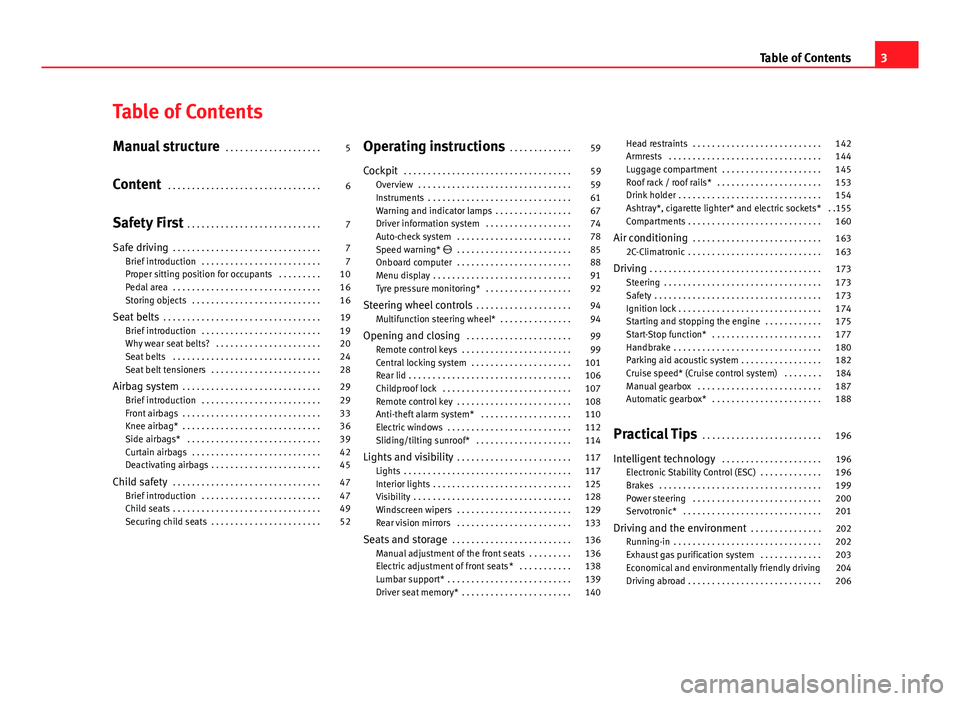
Table of Contents
Manual structure . . . . . . . . . . . . . . . . . . . . 5
Content . . . . . . . . . . . . . . . . . . . . . . . . . . . . . . . . 6
Safety First . . . . . . . . . . . . . . . . . . . . . . . . . . . . 7
Safe driving . . . . . . . . . . . . . . . . . . . . . . . . . . . . . . . 7
Brief introduction . . . . . . . . . . . . . . . . . . . . . . . . . 7
Proper sitting position for occupants . . . . . . . . . 10
Pedal area . . . . . . . . . . . . . . . . . . . . . . . . . . . . . . . 16
Storing objects . . . . . . . . . . . . . . . . . . . . . . . . . . . 16
Seat belts . . . . . . . . . . . . . . . . . . . . . . . . . . . . . . . . . 19
Brief introduction . . . . . . . . . . . . . . . . . . . . . . . . . 19
Why wear seat belts? . . . . . . . . . . . . . . . . . . . . . . 20
Seat belts . . . . . . . . . . . . . . . . . . . . . . . . . . . . . . . 24
Seat belt tensioners . . . . . . . . . . . . . . . . . . . . . . . 28
Airbag system . . . . . . . . . . . . . . . . . . . . . . . . . . . . . 29
Brief introduction . . . . . . . . . . . . . . . . . . . . . . . . . 29
Front airbags . . . . . . . . . . . . . . . . . . . . . . . . . . . . . 33
Knee airbag* . . . . . . . . . . . . . . . . . . . . . . . . . . . . . 36
Side airbags* . . . . . . . . . . . . . . . . . . . . . . . . . . . . 39
Curtain airbags . . . . . . . . . . . . . . . . . . . . . . . . . . . 42
Deactivating airbags . . . . . . . . . . . . . . . . . . . . . . . 45
Child safety . . . . . . . . . . . . . . . . . . . . . . . . . . . . . . . 47
Brief introduction . . . . . . . . . . . . . . . . . . . . . . . . . 47
Child seats . . . . . . . . . . . . . . . . . . . . . . . . . . . . . . . 49
Securing child seats . . . . . . . . . . . . . . . . . . . . . . . 52 Operating instructions
. . . . . . . . . . . . . 59
Cockpit . . . . . . . . . . . . . . . . . . . . . . . . . . . . . . . . . . . 59
Overview . . . . . . . . . . . . . . . . . . . . . . . . . . . . . . . . 59
Instruments . . . . . . . . . . . . . . . . . . . . . . . . . . . . . . 61
Warning and indicator lamps . . . . . . . . . . . . . . . . 67
Driver information system . . . . . . . . . . . . . . . . . . 74
Auto-check system . . . . . . . . . . . . . . . . . . . . . . . . 78
Speed warning* . . . . . . . . . . . . . . . . . . . . . . . . 85
Onboard computer . . . . . . . . . . . . . . . . . . . . . . . . 88
Menu display . . . . . . . . . . . . . . . . . . . . . . . . . . . . . 91
Tyre pressure monitoring* . . . . . . . . . . . . . . . . . . 92
Steering wheel controls . . . . . . . . . . . . . . . . . . . . 94
Multifunction steering wheel* . . . . . . . . . . . . . . . 94
Opening and closing . . . . . . . . . . . . . . . . . . . . . . 99
Remote control keys . . . . . . . . . . . . . . . . . . . . . . . 99
Central locking system . . . . . . . . . . . . . . . . . . . . . 101
Rear lid . . . . . . . . . . . . . . . . . . . . . . . . . . . . . . . . . . 106
Childproof lock . . . . . . . . . . . . . . . . . . . . . . . . . . . 107
Remote control key . . . . . . . . . . . . . . . . . . . . . . . . 108
Anti-theft alarm system* . . . . . . . . . . . . . . . . . . . 110
Electric windows . . . . . . . . . . . . . . . . . . . . . . . . . . 112
Sliding/tilting sunroof* . . . . . . . . . . . . . . . . . . . . 114
Lights and visibility . . . . . . . . . . . . . . . . . . . . . . . . 117
Lights . . . . . . . . . . . . . . . . . . . . . . . . . . . . . . . . . . . 117
Interior lights . . . . . . . . . . . . . . . . . . . . . . . . . . . . . 125
Visibility . . . . . . . . . . . . . . . . . . . . . . . . . . . . . . . . . 128
Windscreen wipers . . . . . . . . . . . . . . . . . . . . . . . . 129
Rear vision mirrors . . . . . . . . . . . . . . . . . . . . . . . . 133
Seats and storage . . . . . . . . . . . . . . . . . . . . . . . . . 136
Manual adjustment of the front seats . . . . . . . . . 136
Electric adjustment of front seats* . . . . . . . . . . . 138
Lumbar support* . . . . . . . . . . . . . . . . . . . . . . . . . . 139
Driver seat memory* . . . . . . . . . . . . . . . . . . . . . . . 140 Head restraints . . . . . . . . . . . . . . . . . . . . . . . . . . . 142
Armrests . . . . . . . . . . . . . . . . . . . . . . . . . . . . . . . . 144
Luggage compartment . . . . . . . . . . . . . . . . . . . . . 145
Roof rack / roof rails* . . . . . . . . . . . . . . . . . . . . . . 153
Drink holder . . . . . . . . . . . . . . . . . . . . . . . . . . . . . . 154
Ashtray*, cigarette lighter* and electric sockets* . .155
Compartments . . . . . . . . . . . . . . . . . . . . . . . . . . . . 160
Air conditioning . . . . . . . . . . . . . . . . . . . . . . . . . . . 163
2C-Climatronic . . . . . . . . . . . . . . . . . . . . . . . . . . . . 163
Driving . . . . . . . . . . . . . . . . . . . . . . . . . . . . . . . . . . . . 173
Steering . . . . . . . . . . . . . . . . . . . . . . . . . . . . . . . . . 173
Safety . . . . . . . . . . . . . . . . . . . . . . . . . . . . . . . . . . . 173
Ignition lock . . . . . . . . . . . . . . . . . . . . . . . . . . . . . . 174
Starting and stopping the engine . . . . . . . . . . . . 175
Start-Stop function* . . . . . . . . . . . . . . . . . . . . . . . 177
Handbrake . . . . . . . . . . . . . . . . . . . . . . . . . . . . . . . 180
Parking aid acoustic system . . . . . . . . . . . . . . . . . 182
Cruise speed* (Cruise control system) . . . . . . . . 184
Manual gearbox . . . . . . . . . . . . . . . . . . . . . . . . . . 187
Automatic gearbox* . . . . . . . . . . . . . . . . . . . . . . . 188
Practical Tips . . . . . . . . . . . . . . . . . . . . . . . . . 196
Intelligent technology . . . . . . . . . . . . . . . . . . . . . 196
Electronic Stability Control (ESC) . . . . . . . . . . . . . 196
Brakes . . . . . . . . . . . . . . . . . . . . . . . . . . . . . . . . . . 199
Power steering . . . . . . . . . . . . . . . . . . . . . . . . . . . 200
Servotronic* . . . . . . . . . . . . . . . . . . . . . . . . . . . . . 201
Driving and the environment . . . . . . . . . . . . . . . 202
Running-in . . . . . . . . . . . . . . . . . . . . . . . . . . . . . . . 202
Exhaust gas purification system . . . . . . . . . . . . . 203
Economical and environmentally friendly driving 204
Driving abroad . . . . . . . . . . . . . . . . . . . . . . . . . . . . 206
3
Table of Contents
Page 9 of 327

7
Safe driving
Safety First
Safe driving
Brief introduction
Dear SEAT Driver
Safety first! This chapter contains important information, tips, suggestions and
warnings that you should read and consider for both your own
safety and for your passengers' safety.
WARNING
● This manual contains important information about the operation of
the vehicle, both for the driver and the passengers. The other sections of
the on-board documentation also contain further information that you
should be aware of for your own safety and for the safety of your passen-
gers.
● Ensure that the on-board documentation is kept in the vehicle at all
times. This is especially important when lending or selling the vehicle to
another person.
Safety equipment
The safety equipment listed here are part of the vehicle's
passenger restraint system. They work together to help re-
duce the risk of injury in a wide variety of accident situa-
tions.
Your safety and the safety of your passengers should not be left to chance.
In the event of an accident, the safety features incorporated in your vehicle
are capable of reducing the risk of injury. These are just a few of the safety
features in your SEAT:
● Three-point seat belts optimised for all seats
● Belt force limiters for the seats
● Belt tension devices for the front seat belts
● Front airbags
● Side airbags in the front and rear seat backrests*
● Head-protection airbags*
● Knee airbag for left-hand drive only
● ISOFIX anchor points* for ISOFIX child safety seats on the outer rear
seats
● Height-adjustable head restraints
● Adjustable steering column
These individual safety features are harmonised to provide you and your
passengers with the best possible protection in case of an accident. Howev-
er, they can only be effective if you and your passengers sit in the correct
position and adjust and use the safety equipment properly.
Safety FirstOperating instructionsPractical TipsTechnical Specifications
Page 10 of 327
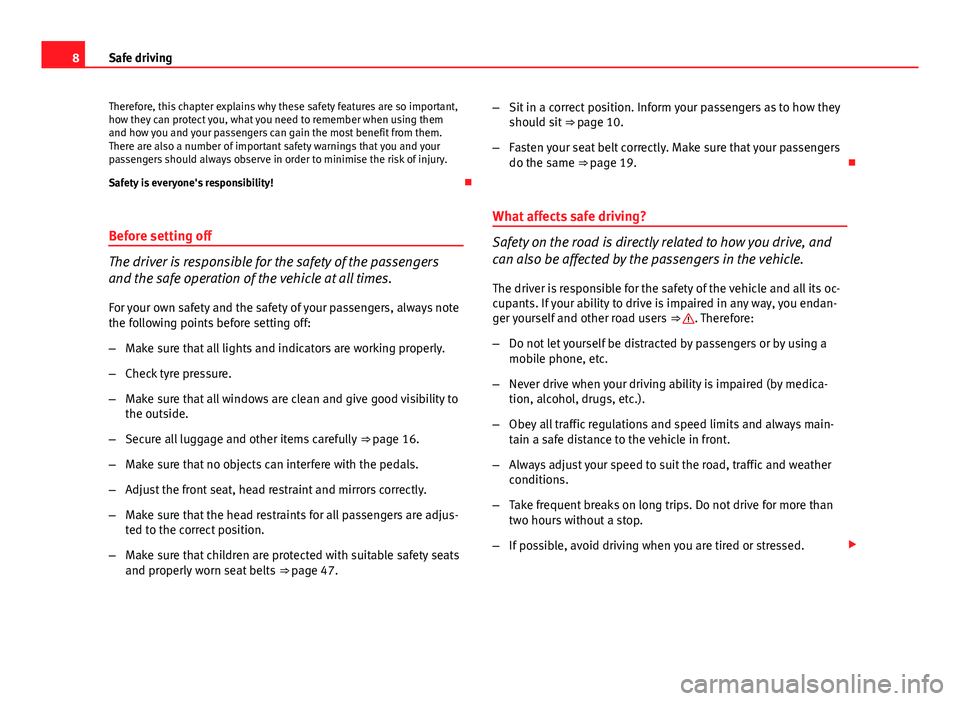
8Safe driving
Therefore, this chapter explains why these safety features are so important,
how they can protect you, what you need to remember when using them
and how you and your passengers can gain the most benefit from them.
There are also a number of important safety warnings that you and your
passengers should always observe in order to minimise the risk of injury.
Safety is everyone's responsibility!
Before setting off
The driver is responsible for the safety of the passengers
and the safe operation of the vehicle at all times. For your own safety and the safety of your passengers, always note
the following points before setting off:
– Make sure that all lights and indicators are working properly.
– Check tyre pressure.
– Make sure that all windows are clean and give good visibility to
the outside.
– Secure all luggage and other items carefully ⇒ page 16.
– Make sure that no objects can interfere with the pedals.
– Adjust the front seat, head restraint and mirrors correctly.
– Make sure that the head restraints for all passengers are adjus-
ted to the correct position.
– Make sure that children are protected with suitable safety seats
and properly worn seat belts ⇒ page 47. –
Sit in a correct position. Inform your passengers as to how they
should sit ⇒ page 10.
– Fasten your seat belt correctly. Make sure that your passengers
do the same ⇒ page 19.
What affects safe driving?
Safety on the road is directly related to how you drive, and
can also be affected by the passengers in the vehicle. The driver is responsible for the safety of the vehicle and all its oc-
cupants. If your ability to drive is impaired in any way, you endan-
ger yourself and other road users ⇒
. Therefore:
– Do not let yourself be distracted by passengers or by using a
mobile phone, etc.
– Never drive when your driving ability is impaired (by medica-
tion, alcohol, drugs, etc.).
– Obey all traffic regulations and speed limits and always main-
tain a safe distance to the vehicle in front.
– Always adjust your speed to suit the road, traffic and weather
conditions.
– Take frequent breaks on long trips. Do not drive for more than
two hours without a stop.
– If possible, avoid driving when you are tired or stressed.
Page 14 of 327
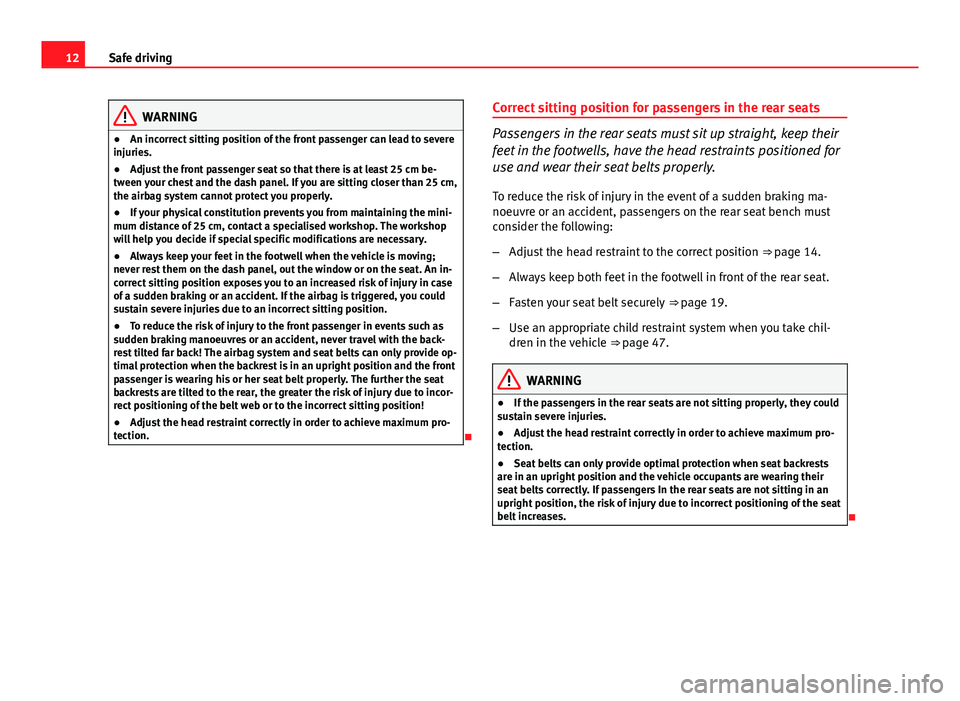
12Safe driving
WARNING
● An incorrect sitting position of the front passenger can lead to severe
injuries.
● Adjust the front passenger seat so that there is at least 25 cm be-
tween your chest and the dash panel. If you are sitting closer than 25 cm,
the airbag system cannot protect you properly.
● If your physical constitution prevents you from maintaining the mini-
mum distance of 25 cm, contact a specialised workshop. The workshop
will help you decide if special specific modifications are necessary.
● Always keep your feet in the footwell when the vehicle is moving;
never rest them on the dash panel, out the window or on the seat. An in-
correct sitting position exposes you to an increased risk of injury in case
of a sudden braking or an accident. If the airbag is triggered, you could
sustain severe injuries due to an incorrect sitting position.
● To reduce the risk of injury to the front passenger in events such as
sudden braking manoeuvres or an accident, never travel with the back-
rest tilted far back! The airbag system and seat belts can only provide op-
timal protection when the backrest is in an upright position and the front
passenger is wearing his or her seat belt properly. The further the seat
backrests are tilted to the rear, the greater the risk of injury due to incor-
rect positioning of the belt web or to the incorrect sitting position!
● Adjust the head restraint correctly in order to achieve maximum pro-
tection.
Correct sitting position for passengers in the rear seats
Passengers in the rear seats must sit up straight, keep their
feet in the footwells, have the head restraints positioned for
use and wear their seat belts properly.
To reduce the risk of injury in the event of a sudden braking ma-
noeuvre or an accident, passengers on the rear seat bench must
consider the following:
–
Adjust the head restraint to the correct position ⇒ page 14.
– Always keep both feet in the footwell in front of the rear seat.
– Fasten your seat belt securely ⇒ page 19.
– Use an appropriate child restraint system when you take chil-
dren in the vehicle ⇒ page 47.
WARNING
● If the passengers in the rear seats are not sitting properly, they could
sustain severe injuries.
● Adjust the head restraint correctly in order to achieve maximum pro-
tection.
● Seat belts can only provide optimal protection when seat backrests
are in an upright position and the vehicle occupants are wearing their
seat belts correctly. If passengers In the rear seats are not sitting in an
upright position, the risk of injury due to incorrect positioning of the seat
belt increases.
Page 17 of 327

15
Safe driving
Examples of incorrect sitting positions
An incorrect sitting position can lead to severe injuries to ve-
hicle occupants.
Seat belts can provide optimal protection only when the belt webs
are properly positioned. Incorrect sitting positions substantially re-
duce the protective function of seat belts and increase the risk of
injury due to incorrect seat belt position. As the driver, you are re-
sponsible for all passengers, especially children.
– Never allow anyone to assume an incorrect sitting position in
the vehicle while travelling ⇒
.
The following list contains examples of sitting positions that could be dan-
gerous for all vehicle occupants. The list is not complete, but we would like
to make you aware of this issue.
Therefore, whenever the vehicle is in motion:
● Never stand in the vehicle.
● Never stand on the seats.
● Never kneel on the seats.
● Never tilt your seat backrest far to the rear.
● Never lean against the dash panel.
● Never lie on the rear bench.
● Never sit on the front edge of a seat.
● Never sit sideways.
● Never lean out of a window.
● Never put your feet out of a window.
● Never put your feet on the dash panel.
● Never put your feet on the surface of a seat.
● Do not allow anyone to travel in the footwell. ●
Never travel without wearing the seat belt.
● Do not allow anyone to travel in the luggage compartment.
WARNING
● Any incorrect sitting position increases the risk of severe injuries.
● Sitting in an incorrect position exposes the vehicle occupants to se-
vere injuries if airbags are triggered, by striking a vehicle occupant who
has assumed an incorrect sitting position.
● Before the vehicle moves, assume the proper sitting position and
maintain it throughout the trip. Before every trip, instruct your passen-
gers to sit properly and to stay in this position during the trip ⇒ page 10,
Proper sitting position for occupants.
Safety FirstOperating instructionsPractical TipsTechnical Specifications
Page 19 of 327
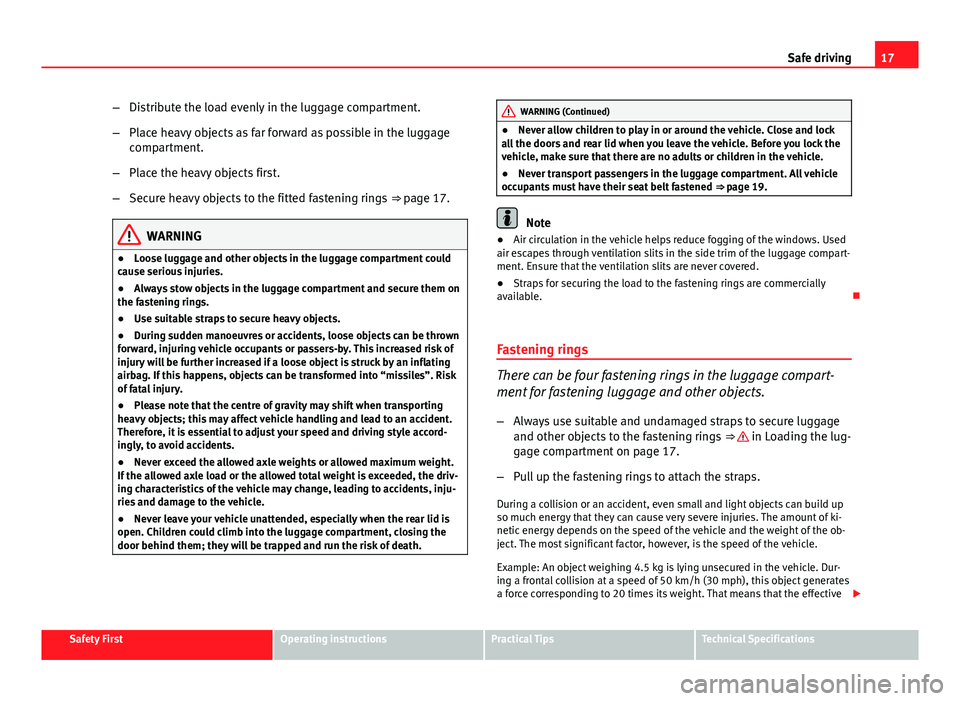
17
Safe driving
– Distribute the load evenly in the luggage compartment.
– Place heavy objects as far forward as possible in the luggage
compartment.
– Place the heavy objects first.
– Secure heavy objects to the fitted fastening rings ⇒ page 17.
WARNING
● Loose luggage and other objects in the luggage compartment could
cause serious injuries.
● Always stow objects in the luggage compartment and secure them on
the fastening rings.
● Use suitable straps to secure heavy objects.
● During sudden manoeuvres or accidents, loose objects can be thrown
forward, injuring vehicle occupants or passers-by. This increased risk of
injury will be further increased if a loose object is struck by an inflating
airbag. If this happens, objects can be transformed into “missiles”. Risk
of fatal injury.
● Please note that the centre of gravity may shift when transporting
heavy objects; this may affect vehicle handling and lead to an accident.
Therefore, it is essential to adjust your speed and driving style accord-
ingly, to avoid accidents.
● Never exceed the allowed axle weights or allowed maximum weight.
If the allowed axle load or the allowed total weight is exceeded, the driv-
ing characteristics of the vehicle may change, leading to accidents, inju-
ries and damage to the vehicle.
● Never leave your vehicle unattended, especially when the rear lid is
open. Children could climb into the luggage compartment, closing the
door behind them; they will be trapped and run the risk of death.
WARNING (Continued)
● Never allow children to play in or around the vehicle. Close and lock
all the doors and rear lid when you leave the vehicle. Before you lock the
vehicle, make sure that there are no adults or children in the vehicle.
● Never transport passengers in the luggage compartment. All vehicle
occupants must have their seat belt fastened ⇒ page 19.
Note
● Air circulation in the vehicle helps reduce fogging of the windows. Used
air escapes through ventilation slits in the side trim of the luggage compart-
ment. Ensure that the ventilation slits are never covered.
● Straps for securing the load to the fastening rings are commercially
available.
Fastening rings
There can be four fastening rings in the luggage compart-
ment for fastening luggage and other objects.
– Always use suitable and undamaged straps to secure luggage
and other objects to the fastening rings ⇒
in Loading the lug-
gage compartment on page 17.
– Pull up the fastening rings to attach the straps.
During a collision or an accident, even small and light objects can build up
so much energy that they can cause very severe injuries. The amount of ki-
netic energy depends on the speed of the vehicle and the weight of the ob-
ject. The most significant factor, however, is the speed of the vehicle.
Example: An object weighing 4.5 kg is lying unsecured in the vehicle. Dur-
ing a frontal collision at a speed of 50 km/h (30 mph), this object generates
a force corresponding to 20 times its weight. That means that the effective
Safety FirstOperating instructionsPractical TipsTechnical Specifications
Page 20 of 327
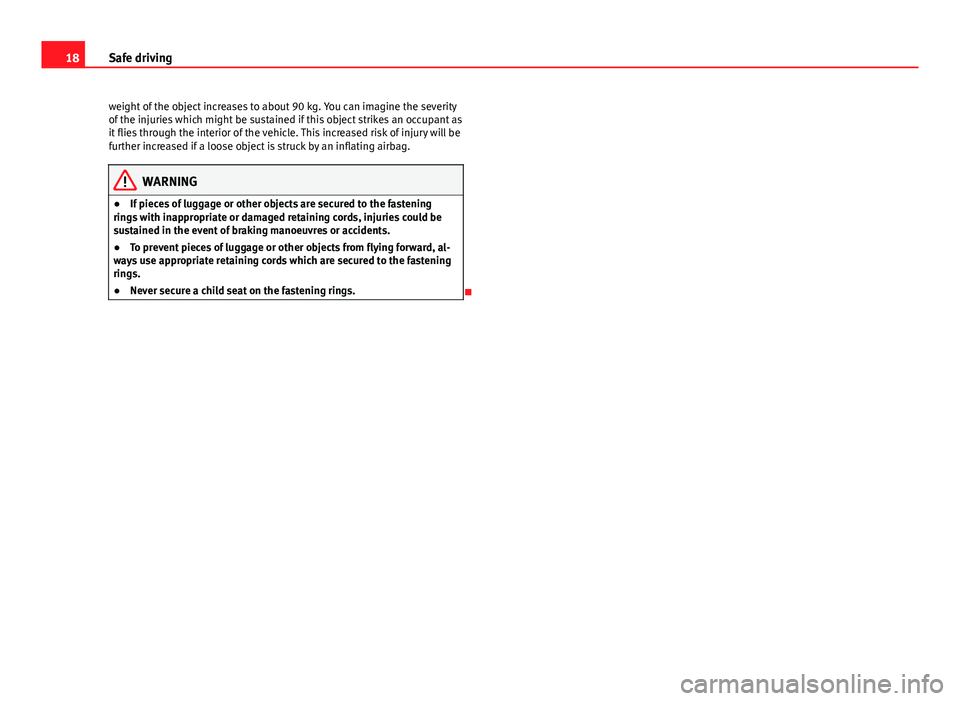
18Safe driving
weight of the object increases to about 90 kg. You can imagine the severity
of the injuries which might be sustained if this object strikes an occupant as
it flies through the interior of the vehicle. This increased risk of injury will be
further increased if a loose object is struck by an inflating airbag.
WARNING
● If pieces of luggage or other objects are secured to the fastening
rings with inappropriate or damaged retaining cords, injuries could be
sustained in the event of braking manoeuvres or accidents.
● To prevent pieces of luggage or other objects from flying forward, al-
ways use appropriate retaining cords which are secured to the fastening
rings.
● Never secure a child seat on the fastening rings.
Page 21 of 327
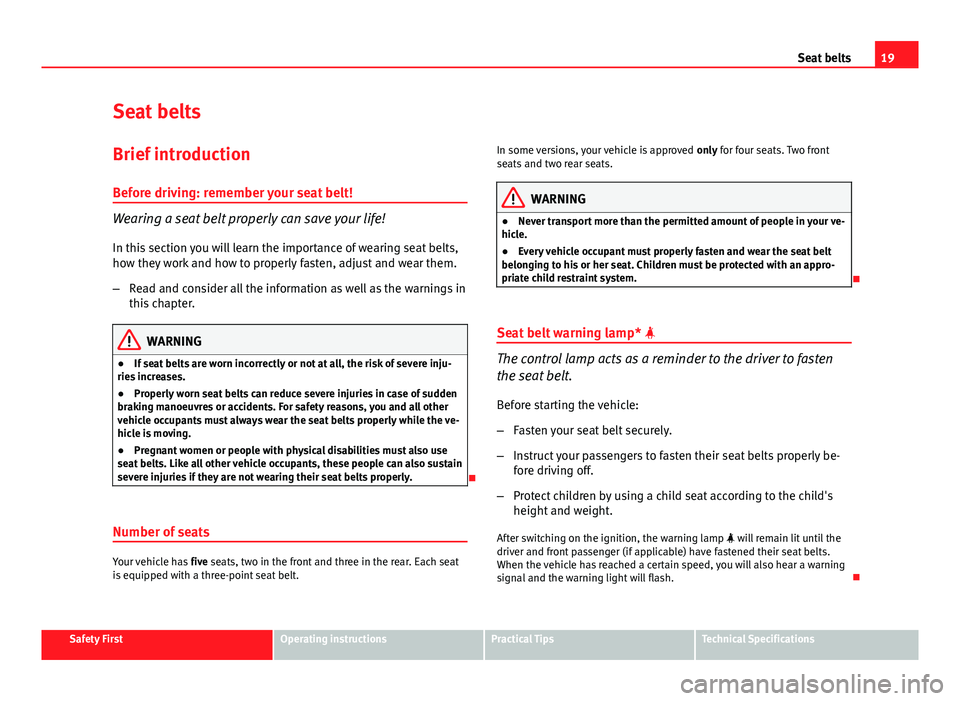
19
Seat belts
Seat belts
Brief introduction Before driving: remember your seat belt!
Wearing a seat belt properly can save your life!
In this section you will learn the importance of wearing seat belts,
how they work and how to properly fasten, adjust and wear them.
– Read and consider all the information as well as the warnings in
this chapter.
WARNING
● If seat belts are worn incorrectly or not at all, the risk of severe inju-
ries increases.
● Properly worn seat belts can reduce severe injuries in case of sudden
braking manoeuvres or accidents. For safety reasons, you and all other
vehicle occupants must always wear the seat belts properly while the ve-
hicle is moving.
● Pregnant women or people with physical disabilities must also use
seat belts. Like all other vehicle occupants, these people can also sustain
severe injuries if they are not wearing their seat belts properly.
Number of seats
Your vehicle has five seats, two in the front and three in the rear. Each seat
is equipped with a three-point seat belt. In some versions, your vehicle is approved
only for four seats. Two front
seats and two rear seats.
WARNING
● Never transport more than the permitted amount of people in your ve-
hicle.
● Every vehicle occupant must properly fasten and wear the seat belt
belonging to his or her seat. Children must be protected with an appro-
priate child restraint system.
Seat belt warning lamp*
The control lamp acts as a reminder to the driver to fasten
the seat belt.
Before starting the vehicle:
– Fasten your seat belt securely.
– Instruct your passengers to fasten their seat belts properly be-
fore driving off.
– Protect children by using a child seat according to the child's
height and weight.
After switching on the ignition, the warning lamp will remain lit until the
driver and front passenger (if applicable) have fastened their seat belts.
When the vehicle has reached a certain speed, you will also hear a warning
signal and the warning light will flash.
Safety FirstOperating instructionsPractical TipsTechnical Specifications
Page 25 of 327
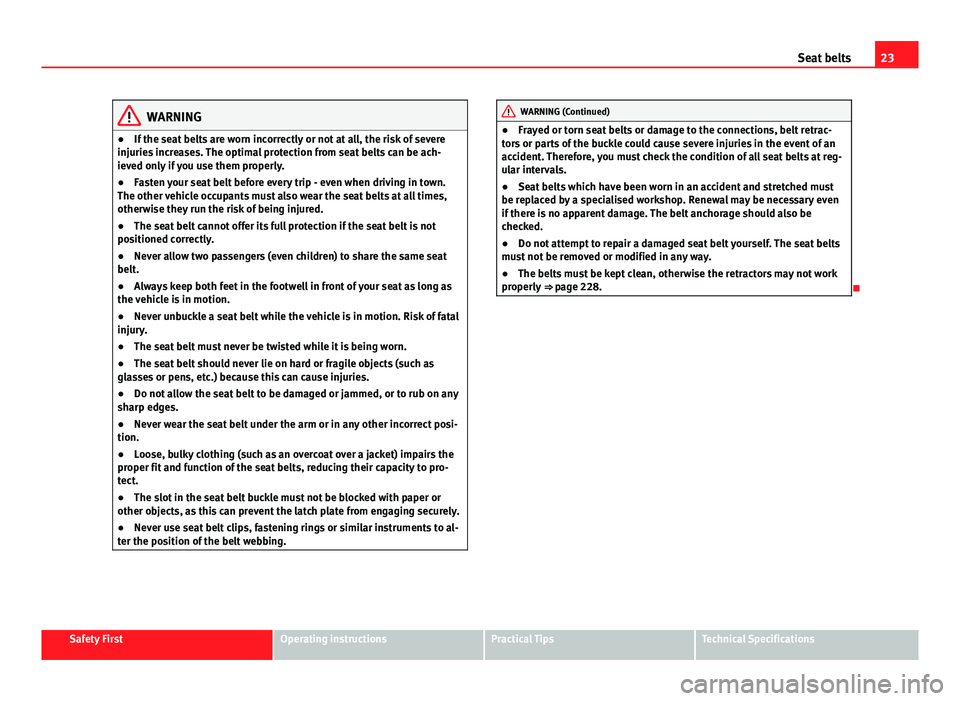
23
Seat belts
WARNING
● If the seat belts are worn incorrectly or not at all, the risk of severe
injuries increases. The optimal protection from seat belts can be ach-
ieved only if you use them properly.
● Fasten your seat belt before every trip - even when driving in town.
The other vehicle occupants must also wear the seat belts at all times,
otherwise they run the risk of being injured.
● The seat belt cannot offer its full protection if the seat belt is not
positioned correctly.
● Never allow two passengers (even children) to share the same seat
belt.
● Always keep both feet in the footwell in front of your seat as long as
the vehicle is in motion.
● Never unbuckle a seat belt while the vehicle is in motion. Risk of fatal
injury.
● The seat belt must never be twisted while it is being worn.
● The seat belt should never lie on hard or fragile objects (such as
glasses or pens, etc.) because this can cause injuries.
● Do not allow the seat belt to be damaged or jammed, or to rub on any
sharp edges.
● Never wear the seat belt under the arm or in any other incorrect posi-
tion.
● Loose, bulky clothing (such as an overcoat over a jacket) impairs the
proper fit and function of the seat belts, reducing their capacity to pro-
tect.
● The slot in the seat belt buckle must not be blocked with paper or
other objects, as this can prevent the latch plate from engaging securely.
● Never use seat belt clips, fastening rings or similar instruments to al-
ter the position of the belt webbing.WARNING (Continued)
● Frayed or torn seat belts or damage to the connections, belt retrac-
tors or parts of the buckle could cause severe injuries in the event of an
accident. Therefore, you must check the condition of all seat belts at reg-
ular intervals.
● Seat belts which have been worn in an accident and stretched must
be replaced by a specialised workshop. Renewal may be necessary even
if there is no apparent damage. The belt anchorage should also be
checked.
● Do not attempt to repair a damaged seat belt yourself. The seat belts
must not be removed or modified in any way.
● The belts must be kept clean, otherwise the retractors may not work
properly ⇒ page 228.
Safety FirstOperating instructionsPractical TipsTechnical Specifications
Page 28 of 327
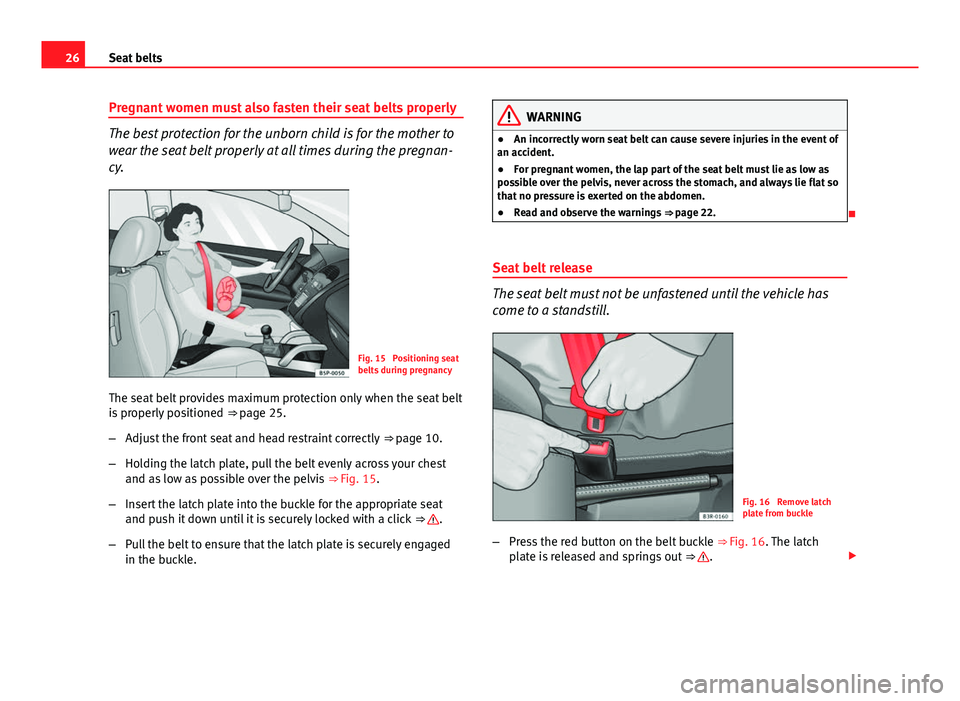
26Seat belts
Pregnant women must also fasten their seat belts properly
The best protection for the unborn child is for the mother to
wear the seat belt properly at all times during the pregnan-
cy.
Fig. 15 Positioning seat
belts during pregnancy
The seat belt provides maximum protection only when the seat belt
is properly positioned ⇒ page 25.
– Adjust the front seat and head restraint correctly ⇒ page 10.
– Holding the latch plate, pull the belt evenly across your chest
and as low as possible over the pelvis ⇒ Fig. 15.
– Insert the latch plate into the buckle for the appropriate seat
and push it down until it is securely locked with a click ⇒
.
– Pull the belt to ensure that the latch plate is securely engaged
in the buckle.
WARNING
● An incorrectly worn seat belt can cause severe injuries in the event of
an accident.
● For pregnant women, the lap part of the seat belt must lie as low as
possible over the pelvis, never across the stomach, and always lie flat so
that no pressure is exerted on the abdomen.
● Read and observe the warnings ⇒ page 22.
Seat belt release
The seat belt must not be unfastened until the vehicle has
come to a standstill.
Fig. 16 Remove latch
plate from buckle
– Press the red button on the belt buckle ⇒
Fig. 16. The latch
plate is released and springs out ⇒
.